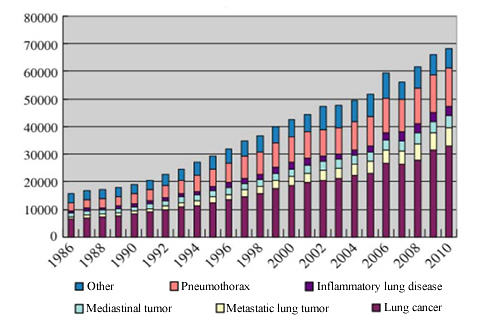| Statistics |
| Contents |
General thoracic surgery includes surgery of the lung, trachea, mediastinum, pleura, chest wall, diaphragm, and esophagus in many countries, but surgery for esophageal diseases are performed mainly by gastro-intestinal surgeons in Japan. Thus, thoracic surgery in this section is limited to operations of the diseases of the lung, pleura, mediastinum, and diaphragm.
Thoracic surgery in Japan is carried out on the basis of meticulous cooperation between the JATS and the Japanese Association for Chest Surgery (JACS), a non-profit organization that was established independently from JATS. Thoracic surgeons first acquire certification in general surgery, and they then go on to acquire certification as specialists in thoracic surgery at the earliest in their eighth year after graduating from medical school. Most of thoracic surgeons acquire certification around 12 years after graduation. Certification can only be acquired when the surgeon has carried out a substantial number of required operations, in addition to which he or she must complete assignments, such as preparing theses, and pass a final examination. As of April 2015, JACS has approximately 3,200 members, of whom 1,315 are specialist thoracic surgeons. The required numbers of operations were performed at 260 core facilities and 385 affiliate institutions.
Figure 3: Annual transition in the number of specialist thoracic surgeons in Japan

The number of thoracic operations in Japan increased in a linear fashion by 2,000 cases a year from 20,000 in 1990 to 60,000 in 2010. Lung cancer accounts for approximately 48% of these cases. The number has increased as smokers grow older, and there has also been a steady increase in adenocarcinoma among non-smokers, so the number of lung cancer operations is expected to continue to increase in the future. The number of lung cancer operations has recently reached a little over 30,000 a year, and the average age of patients is nearly 70 years, with 10% aged 80 years or more. Also, the number of cases of spontaneous pneumothorax continues to increase, reaching just over 10,000 cases every year, so that the total number of thoracic operations in the whole country is currently around 70,000 every year.
Figure 4: Annual Transition in the number of thoracic operations

